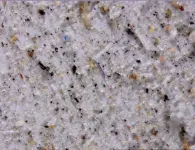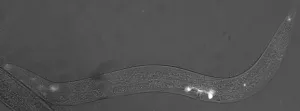Plastic planet: Tracking pervasive microplastics across the globe
2021-04-12
(Press-News.org) Really big systems, like ocean currents and weather, work on really big scales. And so too does your plastic waste, according to new research from Janice Brahney from the Department of Watershed Sciences. The plastic straw you discarded in 1980 hasn't disappeared; it has fragmented into pieces too small to see, and is cycling through the atmosphere, infiltrating soil, ocean waters and air. Microplastics are so pervasive that they now affect how plants grow, waft through the air we breathe, and permeate distant ecosystems. They can be found in places as varied as the human bloodstream to the guts of insects in Antarctica.
Understanding how microplastics move through global systems is essential to fixing the problem, said Brahney. Her new research focuses on how these invisible pieces of plastic get into the atmosphere, how long they stay aloft, and where in our global system we can expect to find hotspots of microplastic deposition.
Plastics enter the atmosphere ... not directly from garbage cans or landfills as you might expect ... but from old, broken-down waste that makes its way into large-scale atmospheric patterns. Roads are a big source of atmospheric plastics, where vehicle tires churn and launch skyward the tiny pieces through strong vehicle-created turbulence. Ocean waves, too, are full of insoluble plastic particles that used to be food wrappers, soda bottles, and plastic bags. These "legacy plastic" particles bob to the top layer of water and are churned by waves and wind, and catapulted into the air.
Another important source for the re-emission of plastics is dust produced from agricultural fields. Plastics are introduced to the soil when fertilizers from waste treatments operations are used (virtually all microplastics that are flushed with wastewater remain with the biowaste after the treatment process). Wind can also be a factor near population centers, whisking broken-down plastic particles into the air.
Once in the atmosphere, plastics could remain airborne for up to 6.5 days--enough time to cross a continent, said Natalie Mahowald, coauthor on the paper. The most likely place for plastic deposition from the atmosphere is over (and into) the Pacific and Mediterranean oceans, but continents actually receive more net plastics from polluted ocean sources than they send to them, according to the models. The U.S., Europe, Middle East, India and Eastern Asia are also hotspots for land-based plastic deposition. Along the coasts, ocean sources of airborne plastic become more prominent, including America's west coast, the Mediterranean and southern Australia. Dust and agriculture sources for airborne plastics factor more prominently in northern Africa and Eurasia, while road-produced sources had a big impact in heavily populated regions the world over.
This study is important, said Brahney, but it is just the beginning. Much more work is needed on this pressing problem to understand how different environments might influence the process ... wet climates versus dry ones, mountainous regions versus flatlands. The world hasn't slowed its production or use of plastic, she said, so these questions become more pressing every passing year.
INFORMATION:
[Attachments] See images for this press release:

ELSE PRESS RELEASES FROM THIS DATE:
2021-04-12
To maximise absorption of nutrients from the diet, the intestinal mucous membrane has a large surface area. However, this also makes it vulnerable to attack from aggressive gut microbes. A new study by Uppsala University researchers now shows that the surface layer of the mucosa, known as the epithelium, can rapidly contract when it recognises a bacterial attack. The results are published in the journal PNAS.
Every year, hundreds of millions of people worldwide suffer from bacterial gut infections of one kind or another, which are often hard to treat. Antibiotics can kill the normal flora of the intestine, ...
2021-04-12
Researchers at the University of British Columbia have discovered three liquid phases in aerosol particles, changing our understanding of air pollutants in the Earth's atmosphere.
While aerosol particles were known to contain up to two liquid phases, the discovery of an additional liquid phase may be important to providing more accurate atmospheric models and climate predictions. The study was published today in PNAS.
"We've shown that certain types of aerosol particles in the atmosphere, including ones that are likely abundant in cities, can often have three distinct liquid phases." says ...
2021-04-12
Using laboratory-grown roundworms as well as human and mouse eye tissue, University of Maryland School of Medicine (UMSOM) researchers have identified a new potential mechanism for age-related macular degeneration--the leading cause of blindness among older adults. The UMSOM researchers say that the findings suggest a new and distinct cause that is different from the previous model of a problematic immune system, showing that the structural organization of the eye's light-detecting cells may be affected by the disease.
The discovery offers the potential to identify new molecular targets to treat the disease. Their discovery was published on April 12 in the Proceedings of the National Academy of Sciences (PNAS).
According to the National Eye Institute, ...
2021-04-12
PRINCETON, N.J.--Increasing diversity remains a key priority at universities, especially in the wake of mass demonstrations in support of racial equality in 2020 following the death of George Floyd. Many universities are guided by the motivation that diversity enhances student learning, a rationale supported by the U.S. Supreme Court.
This approach, however, is a view preferred by white and not Black Americans, and it also aligns with better relative outcomes for white Americans, according to a paper published by Princeton University researchers in the Proceedings of the National Academy of Sciences.
Across eight studies including 1,200 participants, the researchers looked at two different approaches to diversity: an "instrumental rationale," which asserts that including ...
2021-04-12
BOSTON - Many patients with cancer receive immune checkpoint inhibitors that strengthen their immune response against tumor cells. While the medications can be life-saving, they can also cause potentially life-threatening side effects in internal organs. This double-edged sword makes it challenging for clinicians to decide who should be considered candidates for treatment. A new analysis led by researchers at Massachusetts General Hospital (MGH) indicates which patients are at elevated risk of side effects severe enough to require hospitalization. The findings are published in the END ...
2021-04-12
BOSTON - Immune checkpoint inhibitors, which boost the immune system's response against tumor cells, have transformed treatment for many advanced cancers, but short-term clinical trials and small observational studies have linked the medications with various side effects, most commonly involving the skin. A more comprehensive, population-level analysis now provides a thorough look at the extent of these side effects and provides insights on which patients may be more likely to experience them. The research was led by investigators at Massachusetts General ...
2021-04-12
Abstract #LB008
HOUSTON -- A preclinical study led by researchers at The University of Texas MD Anderson Cancer Center shows an antibody-drug conjugate (ADC) targeting surface protein MT1-MMP can act as a guided missile in eradicating osteosarcoma tumor cells without damaging normal tissues. This technology, using precision therapy targeting of cell-surface proteins through a Bicycle toxin conjugate (BTC), shows encouraging results for the treatment of osteosarcoma.
Findings from the study were presented today by Yifei Wang, M.D., a postdoctoral fellow of Pediatrics Research, at the virtual ...
2021-04-12
Blood taken from a small group of children before the COVID-19 pandemic contains memory B cells that bind SARS-CoV-2 and weakly cross-react with other coronaviruses, a new study finds, while adult blood and tissue showed few such cells. "Further study of the role of cross-reactive memory B cell populations... will be important for ongoing improvement of vaccines to SARS-CoV-2, its viral variants, and other pathogens," the authors say. As the COVID-19 pandemic has continued, children have often exhibited faster viral clearance and lower viral antigen loads than adults; whether B cell repertoires against SARS-CoV-2 (and other pathogens) differ between children and ...
2021-04-12
WOODS HOLE, Mass. -- Nitrogen is an element basic for life -- plants need it, animals need it, it's in our DNA -- but when there's too much nitrogen in the environment, things can go haywire. On Cape Cod, excess nitrogen in estuaries and salt marshes can lead to algal blooms, fish kills, and degradation of the environment.
In a study published in Environmental Research Letters, scientists at the Marine Biological Laboratory (MBL) Ecosystems Center examine ways to reduce the nitrogen footprint of smaller institutions, like the MBL, by focusing on a bottom-up approach.
"This bottom-up approach is all about balancing the needs of various stakeholders to come up with the best, ...
2021-04-12
When winter storms threaten to make travel dangerous, people often turn to salt, spreading it liberally over highways, streets and sidewalks to melt snow and ice. Road salt is an important tool for safety, because many thousands of people die or are injured every year due to weather related accidents. But a new study led by Sujay Kaushal of the University of Maryland warns that introducing salt into the environment--whether it's for de-icing roads, fertilizing farmland or other purposes--releases toxic chemical cocktails that create a serious and growing global threat to our freshwater supply and human health.
Previous studies by Kaushal and his team showed that added salts in the environment can interact with soils and infrastructure to release a cocktail of metals, ...
LAST 30 PRESS RELEASES:
[Press-News.org] Plastic planet: Tracking pervasive microplastics across the globe




